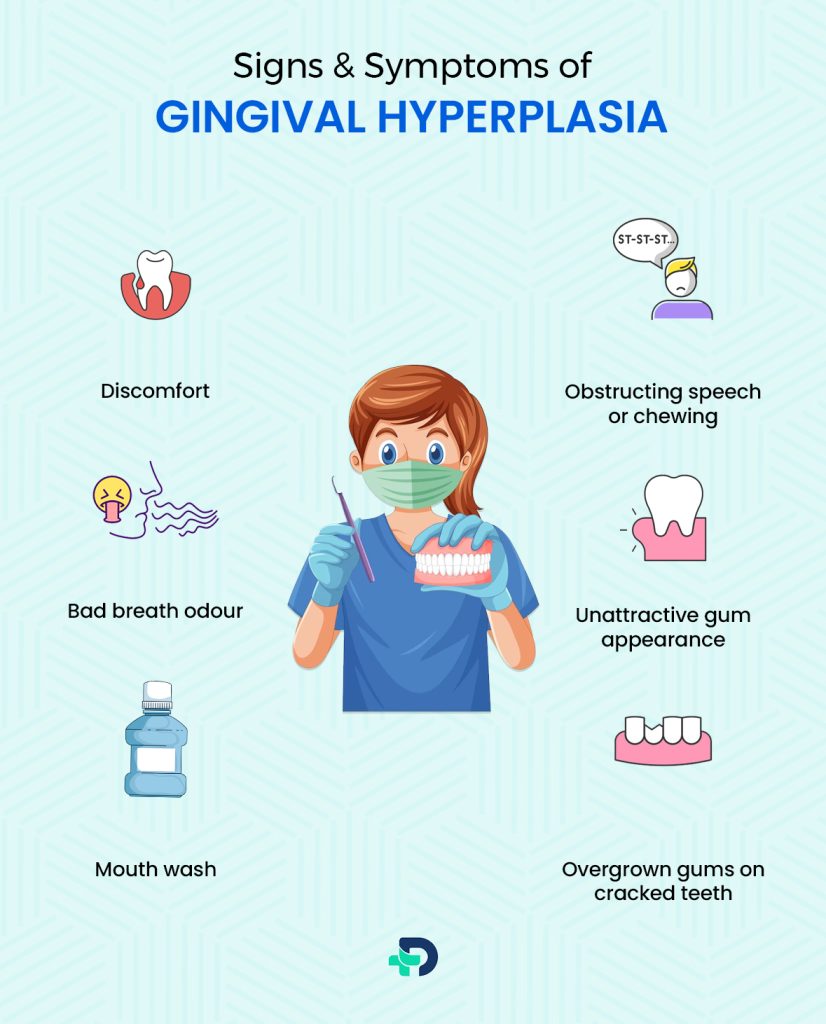Gum Growing Over Teeth: Symptoms, Causes & Management Of Gingival Hyperplasia

- Gingivitis
- 02 Oct 2023
Introduction
Gingival Hyperplasia
Gingival hyperplasia is a condition where the gums around the teeth grow excessively. There are several causes for this illness, however, it is frequently a sign of bad dental hygiene or a negative drug side effect. The alignment of your teeth may be impacted and your chance of developing gum disease may rise if this dental problem is not corrected. By enhancing oral hygiene practices, gingival hyperplasia can be treated. In more serious circumstances, surgical intervention might be necessary. 1 Introduction | Researched based study from National Institutes of Health

Causes & Types
Causes & Types of Gingival Hyperplasia
Why is my gum growing over my tooth?
Four categories can be used to classify the various causes of gingival enlargement which include:
- Inflammatory gingival enlargement
- Drug-induced gingival enlargement
- Hereditary gingival fibromatosis
- Systemic causes of gingival enlargement.
Inflammatory gingival enlargement
- Plaque, which is an accumulation of food particles and germs on the teeth, causes an inflammatory reaction that manifests as gingival swelling that can be localised or generalised.
- It typically occurs due to poor adherence to good oral hygiene practices which generally causes painful, soft, red, and readily bleedable gums that can be resolved by removing plaque and other irritants from the teeth by following proper dental hygiene techniques such as flossing, brushing, etc.
Drug-induced gingival enlargement
- Patients who take specific drugs run the risk of developing enlarged gingiva.
- These cases frequently involve gum tissues that are firm, non-tender, pale pink in colour, and do not easily bleed, unlike inflammatory gingival hyperplasia.
- In extreme situations, the gingiva may fully encase the tooth crowns, which can lead to periodontal disease (gum disease) as well as issues with tooth eruption and alignment.
- When a medication is stopped, a patient may experience partial or complete resolution of medication-induced gingival expansion.
- If the drug cannot be stopped, the excess gingiva may be surgically removed (a procedure known as a gingivectomy), but the problem will probably return.
- Effective oral hygiene practices will lessen the severity of this ailment because the amount of plaque buildup on the teeth tends to make it worse.
Typical drugs that can result in gingival overgrowth include
- Antiseizure drugs (medication to prevent seizures) Ex. carbamazepine, oxcarbazepine
- Immunosuppressants (drugs to lower your immune system’s activity) Ex. tacrolimus, sirolimus
- Calcium channel blockers (drugs used to treat cardiovascular diseases) Ex. felodipine, isradipine.
Hereditary gingival fibromatosis
- This is a rare hereditary condition that frequently shows symptoms in childhood.
- The gingival growth caused by this condition is often slow-growing, generalised, or sporadically localised, firm, and/or pale pink in colour.
- To prevent tooth impaction and displacement, extra gingival growth must surgically be removed which should be followed adequately if the condition recurs.
Systemic causes of gingival enlargement
- Pregnancy, hormone imbalances, and leukaemia (blood disorder) are just a few examples of physiologic and systemic diseases that may encourage localised and/or generalised gingival growth.
- Pregnancy, hormone imbalances, and leukaemia are just a few examples of physiologic and systemic diseases that may encourage localised and/or generalised gingival growth. 2 Causes & Types | Researched based study from American Academy of Oral Medicine
Symptoms

Signs & Symptoms of Gingival Hyperplasia
Gingival hypertrophy symptoms include the following:
- Discomfort
- Obstructing speech or chewing
- Bad breath odour, or halitosis
- Unattractive gum appearance. 3 Symptoms | Researched based study from DermNet
Overgrown gums on cracked teeth
- The body’s normal reaction to the loss of a tooth is for the gum to begin growing over the damaged tooth.
- The body’s attempt to mend the fractured tooth’s damaged area is referred to as “epulis,” and it manifests as this symptom.
- In the absence of a suitable and prompt dental treatment, this condition may be minor or it may worsen uncontrollable.
- This can make biting and chewing uncomfortable, which can harm the way you look when you smile and result in other oral disorders. 4 Symptoms | Researched based study from Authority Dental
Is it normal for gums to grow?
- The gum line recedes from the teeth in a condition known as gum recession, exposing the underlying roots.
- Its development is influenced by a variety of factors, including inheritance, smoking, and vigorous brushing. Surgery, antimicrobial mouthwash, and antibiotics are few examples of treatments.
- Even though gum recession cannot be reversed, treatment can stop it from getting worse. 8 Symptoms | Researched based study from National Institutes of Health
Management
Gingival Hyperplasia Treatment
The symptoms of gingival hyperplasia can typically be reduced with excellent dental hygiene habits and treatment. You may remove irritants like plaque, germs, and leftover food particles by brushing and flossing twice a day which may help to reduce the risk of gingival overgrowth and inflammation. Additionally, you can also take anti-inflammatory drugs such as azithromycin after consulting your dentist to prevent bacterial growth in the gums.
If none of these options are effective, consider having dental procedures which include:
- Gingivectomy
- Laser Excision
- Electrosurgery
- Periodontal Flap surgery
Gingivectomy
- A dentist might advise a gingivectomy for drug-induced gum growth and inherited gingival fibromatosis.
- This surgical procedure aims to improve your smile by removing overgrown gum. Additionally, a gingivectomy lessens the risk of teeth shifting and impaction.
- Your dentist will perform the procedure, removing a little piece of the underlying bone as well as extra gingival tissue.
- The surgeon will next sew up the surgical site to stop bleeding and realign the loose gum tissue and spaces between teeth.
- Depending on how badly the gum is enlarged, you might need to have it removed more than once to prevent the problem from recurring again.
Laser Excision
- Laser excision, as the name implies, entails the removal of swollen gum tissue using sophisticated laser-cutting equipment.
- Throughout the surgical operation, lasers provide greater precision than scalpels.
- Besides lowering the danger of infections, they help hasten the healing and cauterization processes.
- The process, meanwhile, is expensive. To save money, choose a conventional or scalpel gingivectomy.
Electrosurgery
- Like laser excision, electrosurgery uses electric current to shrink the larger portion of the gum to limit overgrowth.
- This procedure minimizes bleeding and hastens the gums’ recovery.
Periodontal Flap Surgery
- A dentist will perform periodontal flap surgery by pulling back a portion of your gums from your teeth and folding it back to remove the diseased tissue.
- Any plaque or tartar accumulation on the tooth’s root surface will also be removed by the oral health professional.
- In order to minimise gaps where bacteria, debris, and plaque can hide, the dentist will then reshape and realign your gum.
- You might, however, have tooth sensitivity and swollen gums for a few days. 5 Management | Researched based study from CDHP Dental Health Project
Pericoronitis
Pericoronitis
Gum Growing Over the Wisdom Tooth
- Inflammation of the gum tissue surrounding your wisdom teeth is known as pericoronitis. When a tooth is still slightly impacted, this condition can occur.
- The symptoms of pericoronitis can be minor to severe and may include poor breath, pus, and/or face puffiness which can become dangerous if left untreated. Hence, care must be given right away.
Symptoms of Pericoronitis:
- Severe toothache in the rear teeth
- Gum tissue swelling and redness
- Fever
- Pus/drainage
- Having difficulty swallowing (trismus)
Risks Associated with Pericoronitis:
- People who are aged 20
- If you are missing some of the wisdom teeth.
- If you are highly stressed
- If you have excess gum tissue growth on a wisdom tooth
- If you are a pregnant woman.
- If you suffer from bad oral hygiene.
Pericoronitis itself is not communicable. The bacteria that cause it, however, can pass from one person to another through saliva. As a result, kissing or sharing cups and eating utensils with someone who has pericoronitis increases the risk of infection.
Treatment for pericoronitis differs depending on the patient. Your dentist might advise cleaning the affected region, taking antibiotics, using mouthwash to treat pericoronitis, or having your wisdom teeth extracted, depending on the level of inflammation.
In order to lessen the signs of pericoronitis at home, you can:
- Use warm salt water to rinse your mouth three to four times per day.
- Use an antimicrobial mouthwash without alcohol two times per day.
- Use over-the-counter painkillers to ease discomfort, such as acetaminophen or ibuprofen.
- Maintain a clean mouth. Brush your teeth at least twice daily, and floss once. 6 Pericoronitis | Researched based study from National Institutes of Health , 7 Pericoronitis | Researched based study from Cleveland Clinic
Natural Remedies
Natural Remedies for Receding Gums
How can I fix my gum growing over my teeth naturally?
Even if you have strong dental hygiene routines, ageing and genetics might lead to gum loss. The process can be slowed down by natural therapies. If the bone and soft tissue supporting your teeth in place become inflamed, you could develop gum disease (periodontitis). The gums will pull back or recede from the teeth if the illness is left untreated.
The following are few natural treatments for receding gums which includes:
- Oil pulling
- Eucalyptus oil
- Salt
- Green tea
- Brushing
- Flossing
Oil Pulling
- People with gingivitis who were instructed to swish a spoonful of premium coconut oil in their mouths for roughly 20 minutes demonstrated a reduction in plaque as a result of the ayurvedic practice of oil pulling.
- This ‘pulls’ the oil between the teeth which should be spit out after rinsing the mouth with warm tap or saline water followed by cleaning of your teeth.
Eucalyptus Oil
- Eucalyptus oil, a non-inflammatory germicide, may be used to treat receding gums and promote the development of new gum tissue, which will help to slow the recession of gums.
Salt
- When administered appropriately, salt works as a bacterial agent that soothes and lessens gum irritation.
- Rinsing two to three times a day is often indicated for receding gums.
- Gum recession is often effectively reduced by drinking green tea, which can help promote healthy teeth and gums.
- It is advised to drink one to two cups of green tea every day for the best results.
Brushing
- At least twice daily, brush your teeth for two minutes or longer. To eliminate plaque and debris from your teeth and along the gum line, use a soft-bristled toothbrush.
- A medium- or hard-bristled brush could harm your gums, root surface, and tooth enamel depending on how aggressively you brush.
Flossing
- It is recommended to floss once a day as a crucial component of maintaining healthy teeth and gums.
- Flossing helps to eliminate debris from between teeth that can contribute to plaque accumulation. 9 Natural Remedies | Researched based study from Cleveland Clinic
Do gum flaps go away?
- The gum flap will typically disappear naturally as the tooth continues to develop. However, you could require additional treatment if the flap lasts or causes discomfort.
- It’s best to speak with a dental expert who can evaluate your particular condition and offer useful advice. 10 Natural Remedies| Researched based study from PeaceHealth
Takeaway
Gingival Hyperplasia – Maintain Regular Oral Care
- You can have gingival hyperplasia if your gums are encroaching on your teeth or if they have a projecting bulge.
- In more severe situations, your gums may totally encase your teeth, making it challenging to practice good oral hygiene practices
- To avoid bacteria and tartar accumulation on the surface of the teeth and below the gum line, maintain a regular dental care and maintenance regimen.
- Discuss changing doses or stopping the medication with the healthcare professional if the condition is drug-related
- Make an appointment with your dentist to have the condition managed if you suspect gum growth or exhibit symptoms of the ailment. 1 Takeaway| Researched based study from National Institutes of Health ,2 Takeaway | Researched based study from American Academy of Oral Medicine , 5 Takeaway | Researched based study from CDHP Dental Health Project
Any feedback on this article?
 This Articles content was accurate
This Articles content was accurate Very Informative Article
Very Informative Article I have a question or a comment
I have a question or a comment
 This article contains inaccurate content
This article contains inaccurate content This article was not helpful
This article was not helpful I have a question or a comment
I have a question or a comment
We appreciate your helpful feedback!
Checkout our social pages
References
-
National Institutes of Health
Introduction | Takeaway
-
American Academy of Oral Medicine
Causes and Types | Takeaway
-
DermNet
Symptoms
-
Authority Dental
Symptoms
-
CDHP Dental Health Project
Management | Takeaway
-
National Institutes of Health
Pericoronitis
-
Cleveland Clinic
Pericoronitis
-
National Institutes of Health
Symptoms
-
Cleveland Clinic
Natural Remedies
-
PeaceHealth
Natural Remedies




































